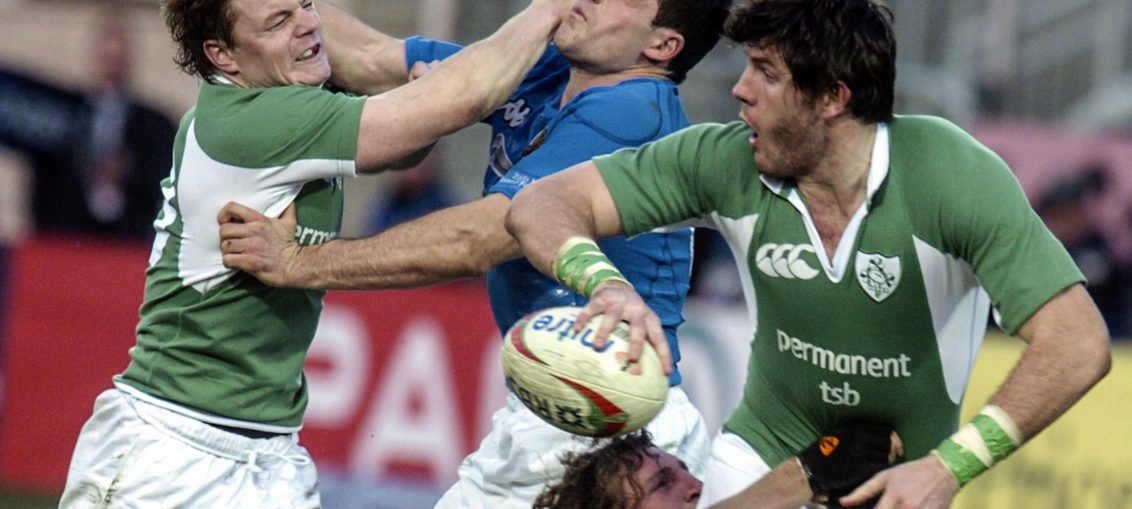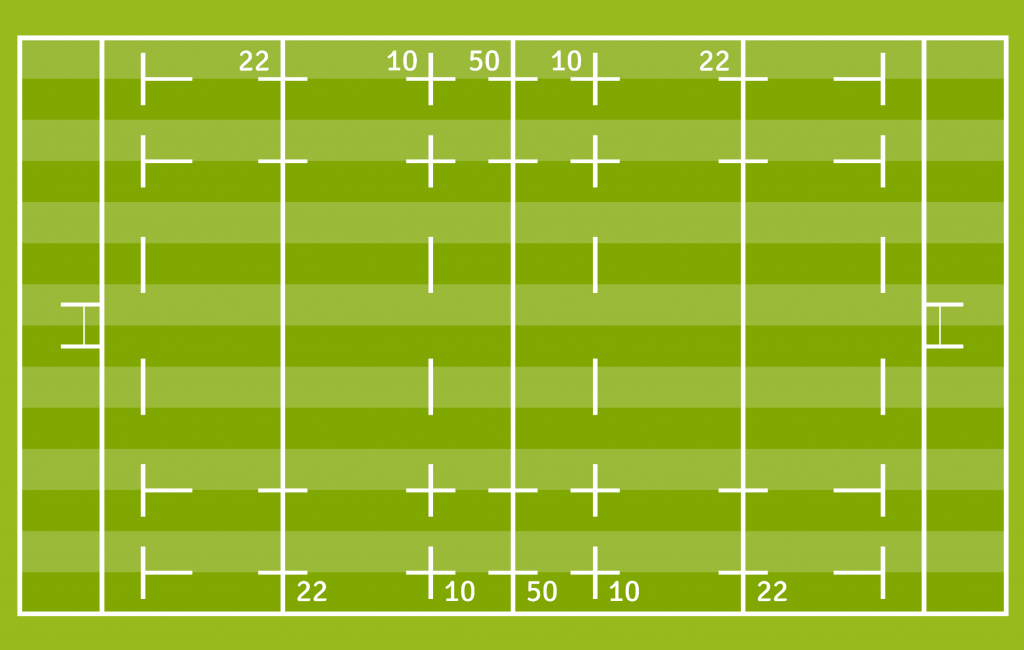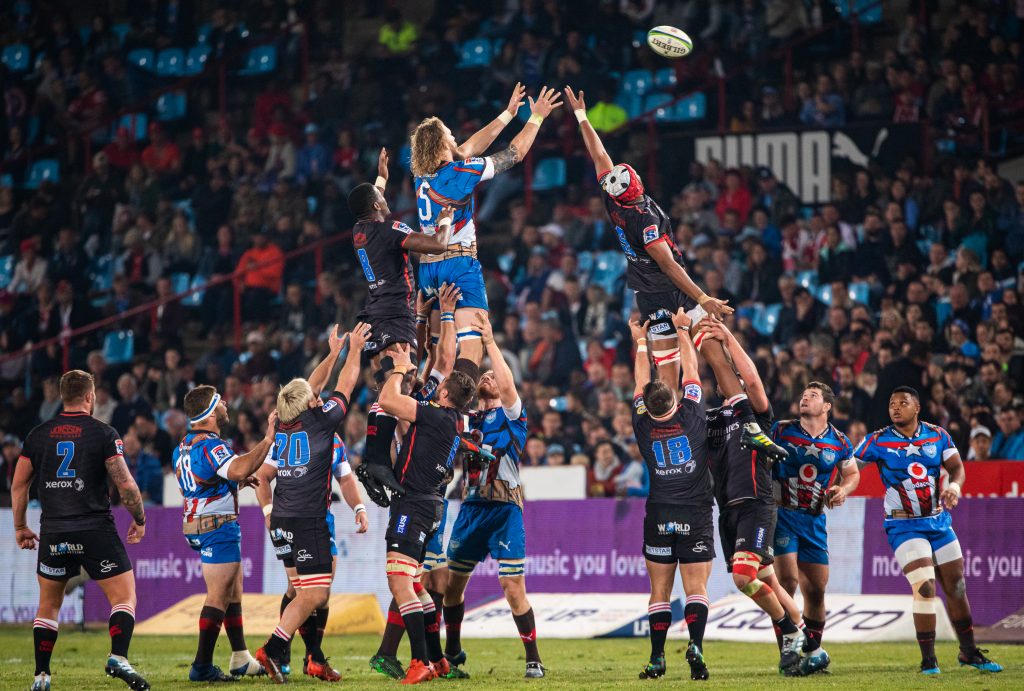
Trying to follow Rugby, but don’t get the rules? Don’t worry, we’ve got you covered. Take the time to learn the rugby rules (also called laws) and you’ll find the game is much more enjoyable to watch. The below rules apply to Rugby Union, unless otherwise specified.
1. The Ground
A rugby field, also known as a pitch, is 110 yards long, plus two 25 yard in-goal areas and 77 yards wide. It is longer and wider than a standard football field, which measures 120 yards long (including the end zones) by 53 yards wide.
Lines on a Rugby Field In addition to the goal lines, there are also lines 25 yards from each goal line. These are referred to as the 22 meter lines. The halfway line splits the field and two 10 meter lines run parallel to the halfway line on either side. There are also two lines that run the length of the field five meters from touch lines.

Goal post The goal posts in rugby are 18.5 feet apart, which is slightly wider than the posts American pro football. The rugby goal posts are situated on the goal line, as it once was in football.
2. The Ball
The rugby ball seems to be the only thing in the game that doesn’t have a nickname It’s just called the ball. It consists of four leather or synthetic panels sewn together. It measures almost 30” long and 23” around.

Compared to an NFL ball, a rugby ball is about an inch longer and is more egg shaped. Rugby balls do not have raised laces, and they are not signed by Roger Goodell or any other almighty power.
3. The Teams
The sport has plenty of star players, but rugby is truly a team sport. Each team has 15 players on the field, with another 8 substitutes ready when needed. With all those players, it can be tough to figure out who is playing what position. Luckily a player’s position commonly dictates what uniform number they wear. For example, the scrum half always wears number nine and the fly half always wears number 10. The jersey numbering system is not part of the rugby rules, but it’s almost always used at the higher levels.
Also check out our Complete Guide to Rugby Positions.
4. Player’s Clothing
Other than a jersey and shorts, rugby players wear little equipment. High socks and boots (cleats) are worn by all. Scrum caps and mouth pieces are optional pieces of equipment that both help protect against head injuries. Compression shorts are allowed and commonly worn. Other less common, but allowable pieces of equipment include shin guards, fingerless gloves, and shoulder pads.
5. Time
A rugby game is 80 minutes long, broken into two 40-minute halves with a 15 minute halftime break. The clock does/doesn’t stop, and the referee can add time at their discretion. Yes- the game can end in a tie in most competitions. You may also hear a game referred to as a match, or test match. A test match is a game played between the national teams of two countries.
6. Match officials
Officials Rugby matches are controlled by a head referee and two assistant referees, also known as touch judges.
The assistant referees are responsible for signaling when the ball goes into touch (out of bounds), signaling whether a kick attempt is successful, and alerting the head referee to foul play.
The head referee is responsible for enforcing rugby rules, keeping time, and keeping score. The head referee is the judge and jury of the match. Like most sports, the referees decisions can have major impacts on the game. However unlike other sports, the referee is well respected and rarely argued with.
7. Advantage
The referee does not have to stop play for an infringement if the non-offending team would have an advantage if play were to continue. In other words, the ref can use their discretion and decide whether to stop play for a penalty. A similar rule exists in soccer.
8. Scoring
There are two basic ways of scoring in rugby. Touching the ball down in the goal area, called a try, and kicking the ball between the goal posts.
Try (5 points) A try similar to a touchdown, but in rugby the player must touch the ball to the ground over the goal line to score a try. In fact, that’s where the word touchdown came from.
Conversion (2 points) The extra points of rugby, attempted after a try. The interesting part about the conversion kick is that is attempted from on a line directly out from where the ball was touched down on the try. It’s advantageous for the ball to be touched down toward the middle of the field on a try. That way the conversion is kicked from straight on, instead of on an angle.
The opposing team does have a chance to charge the kicker during a conversion attempt. However, they have to stay behind their goal line until the kicker begins his approach, so blocked conversion attempts are rare.
Penalty Try (7 points)
A penalty try is given if the referee deems that a penalty by the opposing team prevents what would likely have otherwise been a successful try. The penalty try is always kicked from between the posts, which usually results in a make.
Penalty Goal (3 points)
A penalty goal is a kick at goal that can be attempted after a penalty by the opposing team. The kick is taken from the spot of the penalty and can not be contested by the opposing team. The kicker has the option of using a kicking tee or pile of sand to prop the ball. Some players still use sand to sculpt a tee, but it is becoming less common.
Dropped Goal (3 points)
A dropped goal is scored by drop-kicking the ball through the goal posts during open play.
9. Foul Play
Foul play involves any unfair or dangerous play and results in the offending player being warned or possibly sent off the field.
Common examples of foul play include:
Obstruction – Pushing a player who doesn’t have the ball, preventing a player from tackling the ball carrier. In other words, blocking is illegal in rugby.
Unfair play – Intentionally breaking rules of the game, such as committing an intentional knock on, or anything the referee deems to be time wasting
Dangerous play – Here’s a sampling of what is considered dangerous play:
- Biting
- Kicking
- Punching
- Verbal abuse
- Late hits
- Tackling a player who does not have the ball
- Picking up a player and dropping him to the ground
Foul play can result in a player being cautioned or carded. A player receiving a yellow card must leave the field for 10 minutes, leaving his team shorthanded. A more egregious offense, such as a deliberate blow to the head, can result in the player receiving a red card and being sent off for the remainder of the game.
10. Offsides
A defending player is offside if he is in front of the line of the back foot of the ruck. He is also offside if he picks up the ball from a knock-on if he was in front of the player, both of these will result in a penalty to the opposition. However, a player can be accidentally offside if one of his own teammates either run into him or kick the ball at him, this will result in a scrum to the opposition.
11. Knock On
A player cannot intentionally or unintentionally hit the ball forward with their arms or hands. This is called a “knock on” and results in a scrum being given to the opposing team. Knock ons commonly occur when a player can’t cleanly catch the ball and it bounces off of them. Another example of a knock out is when a player tries to pick up a fumble and inadvertently hits the ball forward. It is not considered a knock on If a defending player blocks a kick and knocks the ball forward in the process.
12. Kicking
Every restart from a kick must be done with a dropkick, this applies to kickoffs and 22-metre dropouts. A kickoff is taken on the halfway line and must not go directly into touch, if a kick goes directly into touch, the opposition may choose a scrum on the halfway line or for the kick to be retaken, the same applies for a 22-metre dropout.
13. Players on the ground in open play
If a ball-carrying player goes to ground with the ball, he must either
- Get up immediately
- Release the ball
- Pass the ball
If he doesn’t do one of these things, a penalty will be awarded to the opposition. A defending player on the floor cannot attempt to play the ball or tackle a player, this will result in a penalty to the opposition.
14. Tackle
A tackle can be made anywhere in the field and the tackler must release the tackled player once he’s on the ground otherwise a penalty will be given to the opposition. The tackle must be below the shoulders to ensure player safety. If the tackler makes a high tackle, a penalty will be awarded to the opposition and there could be further possible sanctions including yellow and red cards.
15. Ruck
A ruck is formed when at least one player from each team are contesting over the ball which is on the ground. The ruck is contested by players pushing against each other in the hope of getting the ball. The players in the ruck must stay on their feet otherwise a penalty will be given to the opposite side. If a player wants to join a ruck, they must join in from the back foot of the ruck otherwise it is a penalty offence.
For more on rucks, see our article What the Ruck?
16. Maul
A maul consists of a ball carrier along with a player from each team, the players will stay on their feet and attempt to push the maul forwards. Players joining a maul must do so from an onside position which means behind the back foot of the furthest back player. If the maul is stationary, the referee will give a scrum against the team that carried the ball into the maul. However, the defending team may not attempt to collapse the maul as this will result in a penalty to the opposition.
17. Mark
A player can call a mark if he catches the ball cleanly in his own 22 or his in-goal area by simply shouting “mark.” Once a mark is called, the referee will give a free-kick to the team that made the mark. A player may not call a mark from a restart (a kickoff or a 22-metre drop out,) however, he may call a mark even if the ball hits the goalpost or crossbar. The free-kick must be taken from the same place that the mark was called unless it was called in his in-goal area, in which case, the free-kick will be taken on the 5-metre line. If used probably the rugby mark can help you get out of trouble.
18. Touch, quick throw and lineout
In touch is similar to out of bounds in other sports. According to rugby rules, the ball is in touch if:
- The ball touches or goes over the touchline
- The player goes in touch or goes over the touchline
If either of these outcomes happen, a lineout will be given to the opposition. A quick throw can be taken if a player uses the same ball that was previously used and the ball is thrown further than the 5-meter line. If these rules aren’t followed, a free kick will be given to the opposition.

At a lineout, the team who’s throwing in decide how many numbers they’ll have in the lineout as the opposite team must either match the numbers or have fewer players in the line. The hooker must throw the ball straight into the line and the ball must pass the 5-metre line. If either of these regulations aren’t met, a free kick will be awarded to the opposite side.
19. Scrum
A scrum is awarded to the opposite team if a player accidentally drops the ball (a knock-on.) A scrum consists of 8 players from each team including 3 specialist front rowers. The scrum takes place in the same place that the knock-on took place. If the scrum is collapsed, a penalty is given to the opposite team. The scrum-half must feed the ball in a straight line so that both of the hookers have a chance to hook the ball back to their side. If the scrum-half doesn’t feed the ball in a straight line, a free kick will be awarded to the opposition.
Also check out our Rookie’s Guide to Scrums.
20. Penalty and free-kick
A penalty or free-kick must be taken on or behind the mark of which the infringement was made. If a penalty is given, the captain may choose:
- To tap the ball and run
- A scrum
- Kick for goal
- Kick for touch (lineout to the team that was awarded the penalty)

If a free kick is given, the captain may choose:
- A scrum
- Kick for touch (lineout to the opposition)
- To tap the ball and run
At a kick for goal, the opposition players may stand anywhere on the pitch as long as they’re 10-meters away from the place-kick. They may not move or make noise whilst the player is taking the kick, if the kick is scored, the team will be awarded 3 points.
21. In-goal
The ball can be grounded in-goal if the player has control of the ball and exerts downward pressure in the in-goal area. If an attacking player grounds the ball in-goal, a try will be awarded. If a defending player grounds the ball in-goal from an attacking team’s kick, a 22-meter drop out will be awarded. However, if a defending player grounds the ball in-goal, a 5-meter scrum will be awarded to the opposition.
